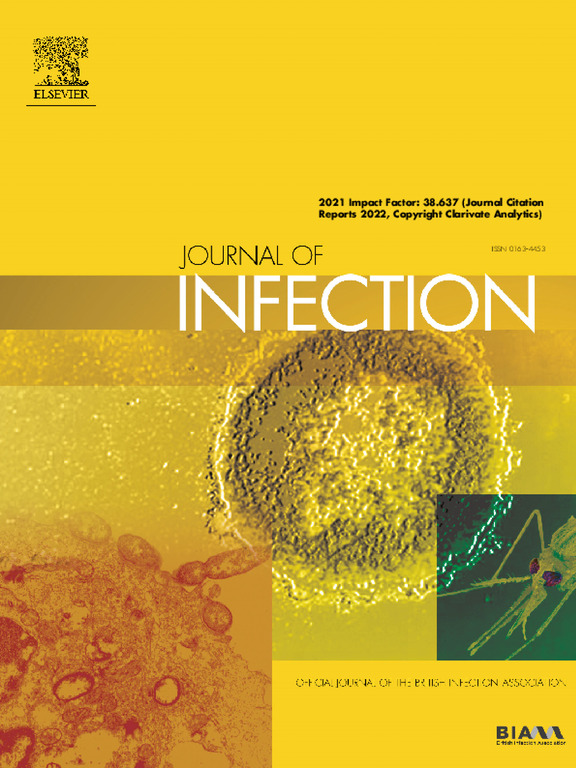靶向婴儿RSV免疫策略的有效性(2024-2025):一项高监测环境下的多中心匹配病例对照研究
IF 11.9
1区 医学
Q1 INFECTIOUS DISEASES
引用次数: 0
摘要
nirsevimab是一种抗呼吸道合胞病毒(RSV)的长效单克隆抗体,最近被引入预防婴儿RSV相关住院。尽管在临床试验中证明了有效性,但关于靶向免疫策略的实际数据仍然有限。我们的目的是评估nirseimab在预防12个月以下婴儿rsv相关住院方面的有效性,在一个优先考虑4月以后出生的婴儿的季节性项目中。方法我们在意大利7家医院进行了一项前瞻性、多中心、匹配的病例对照研究,研究时间为2024-2025年RSV流行季。因聚合酶链反应确诊的呼吸道合胞病毒细支气管炎住院的婴儿按年龄和入院日期与因非呼吸道原因住院的对照组1:2匹配。数据通过电子病历收集。免疫效果(IE)使用条件logistic回归进行估计,校正了出生性别、胎龄、出生体重和临床危险因素。进行了两个预先指定的分层分析和使用处理加权逆概率(IPTW)的敏感性分析。结果共纳入138例患儿(46例,对照组92例)。调整后IE为89.5% (95% CI: 60.3-97.2%)。分层分析在4月1日以后出生的婴儿(IE: 88.4%, 95% CI: 56.5-96.9%)和没有危险因素的婴儿(IE: 88.1%, 95% CI: 45.7-97.4%)中得出了类似的结果。IPTW分析证实有保护作用(IE: 79.6%, 95% CI: 53.5-91.0%)。结论:本研究提供了支持nirseimab在靶向季节性免疫框架中的有效性的真实证据。这些发现可能为不同医疗机构的分阶段实施策略和RSV预防政策提供信息。本文章由计算机程序翻译,如有差异,请以英文原文为准。
Effectiveness of a targeted infant RSV immunization strategy (2024–2025): A multicenter matched case-control study in a high-surveillance setting
Background
Nirsevimab, a long-acting monoclonal antibody against respiratory syncytial virus (RSV), was recently introduced to prevent infant RSV-related hospitalizations. Although efficacy has been demonstrated in clinical trials, real-world data on targeted immunization strategies remain limited. We aimed to evaluate the effectiveness of nirsevimab in preventing RSV-associated hospitalizations in infants under 12 months, within a seasonal program prioritizing infants born from April onwards.
Methods
We conducted a prospective, multicenter, matched case-control study across seven Italian hospitals during the 2024–2025 RSV season. Infants hospitalized with PCR-confirmed RSV bronchiolitis were matched 1:2 by age and date of admission to controls hospitalized for non-respiratory causes. Data were collected via electronic medical records. Immunization effectiveness (IE) was estimated using conditional logistic regression adjusted for sex assigned at birth, gestational age, birth weight, and clinical risk factors. Two pre-specified stratified analyses and a sensitivity analysis using inverse probability of treatment weighting (IPTW) were performed.
Results
A total of 138 infants were included (46 cases, 92 controls). Adjusted IE was 89.5% (95% CI: 60.3–97.2%). Stratified analyses yielded similar results among infants born after April 1 (IE: 88.4%, 95% CI: 56.5–96.9%) and those without risk factors (IE: 88.1%, 95% CI: 45.7–97.4%). IPTW analysis confirmed protection (IE: 79.6%, 95% CI: 53.5–91.0%).
Conclusions
This study provides real-world evidence supporting the effectiveness of nirsevimab in a targeted seasonal immunization framework. These findings may inform phased implementation strategies and RSV prophylaxis policies in varied healthcare settings.
求助全文
通过发布文献求助,成功后即可免费获取论文全文。
去求助
来源期刊

Journal of Infection
医学-传染病学
CiteScore
45.90
自引率
3.20%
发文量
475
审稿时长
16 days
期刊介绍:
The Journal of Infection publishes original papers on all aspects of infection - clinical, microbiological and epidemiological. The Journal seeks to bring together knowledge from all specialties involved in infection research and clinical practice, and present the best work in the ever-changing field of infection.
Each issue brings you Editorials that describe current or controversial topics of interest, high quality Reviews to keep you in touch with the latest developments in specific fields of interest, an Epidemiology section reporting studies in the hospital and the general community, and a lively correspondence section.
 求助内容:
求助内容: 应助结果提醒方式:
应助结果提醒方式:


